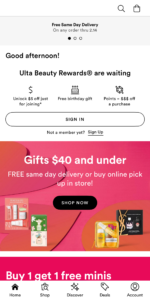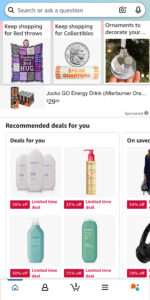Designing Retail Loyalty Programs That Work
At CommerceNext, we get the chance to learn from top retail leaders at Target, Sephora, Ulta Beauty and others who have created the most successful loyalty programs in the industry. Here are some of the key strategies they use to drive customer loyalty and engagement; and join us at the 2025 CommerceNext Growth Show, June 24-26 in NYC, for deeper discussions.
Types of Loyalty Programs
1. Points-based: Customers earn points per purchase, redeemable for discounts or products.
- Pros: Simple, encourages frequent shopping.
- Cons: Can become predictable, may not build deep brand loyalty.
2. Tiered: Higher spending unlocks better rewards.
- Pros: Encourages engagement, and creates exclusivity.
- Cons: Can feel complex or too exclusionary.
3. Partner-based: Multiple brands collaborate on shared rewards.
- Pros: Expands customer base, adds reward variety.
- Cons: Complex management and potential customer confusion.
4. Subscription-based: Customers pay for exclusive benefits.
- Pros: Steady revenue, high perceived value.
- Cons: Not appealing to infrequent shoppers.
5. Referral-based: Rewards for referring friends.
- Pros: Cost-effective, fosters organic growth.
- Cons: Less effective without an engaged base.
6. Value-based: Aligns with ethical causes. Companies might donate to a charity on behalf of the customer or support community initiatives.
- Pros: Creates emotional connection and attracts conscious consumers.
- Cons: Harder to measure ROI.
Keys to a Successful Loyalty Program
1. Include Personalization
Leverage purchase history data, preferences and behavior to offer targeted recommendations, promotions and exclusive offers. Make customers feel seen with tailored experiences.
2. Providing Convenience through Omnichannel Strategies
Many loyalty programs fall short due to complexity, limited accessibility or poor integration between online and offline shopping. Common issues include difficulty redeeming rewards, unclear point tracking and inconsistencies in program benefits across platforms.
To combat these challenges, retailers should focus on:
- Intuitive Digital Platforms: Use easy-to-navigate loyalty dashboards that display points, rewards and redemption options clearly.
- Cross-Channel Convenience: Customers should be able to easily navigate from mobile, online and in-store channels.
- Real-Time Updates: Implement real-time tracking of rewards and point balances to prevent customer confusion or frustration.
- Simplified Redemption Process: Avoid excessive restrictions on how and when rewards can be used.
3. Build Community and Engagement
Brands can connect with customers through genuine, unique social media content, or by creating forums and communities where customers can share experiences and connect with other brand enthusiasts.
4. Be Ready for Adaptability and Innovation
Staying ahead of market trends and adopting new technologies keeps your loyalty program relevant and competitive. Incorporating sustainable practices and being responsive to changing consumer preferences demonstrates forward-thinking and resonates with younger customers.
Benefits of Loyalty Programs
- Increase Retention & Revenue – Loyalty members shop more often and spend more. A study from McKinsey showed that loyalty program members are 43% more likely to buy weekly and are 62% more likely to spend more.
- Personalized Marketing – Tailored information makes it easier for customers to shop.
- Enhance Customer Experience – Make shoppers feel valued and connected.
- Reduce Churn – Strong rewards keep customers from switching to competitors.
- Improve Marketing Efficiency – Loyalty data informs more strategic, ROI-driven campaigns.
Examples of the Best Retail Loyalty Programs
1. Ulta Beauty’s Ultamate Rewards blends points-based and tiered models. Members earn 1 point per dollar, with higher tiers unlocking perks like faster point accumulation and exclusive sales. Personalized promotions and omnichannel integration make it highly engaging.
Reasons why this program is successful:
- Personalization: Ulta uses customer data to provide tailored recommendations, personalized offers, birthday rewards and app/website customization.
- Omnichannel strategies: Customers earn and redeem points seamlessly online and in-store, with real-time balance updates.
- Community engagement: Influencers and beauty experts engage customers via social media, while Platinum and Diamond members enjoy exclusive product launches and VIP experiences.
- Adaptability and innovation: Ulta embraces sustainability trends and enhances technology with AR makeup try-ons, personalized recommendations and quick reward access.

2. Amazon Prime is a subscription-based model offering free shipping, streaming, exclusive deals and Prime Day. Its evolving benefits and AI-driven personalization make it one of the most comprehensive loyalty programs.
Reasons why this program is successful:
- Personalization: Amazon uses customer data to suggest relevant products, personalized discounts and early access to sales for Prime members.
- Omnichannel strategies: Prime benefits, including free one-day or same-day shipping and one-click checkout, apply across desktop, mobile, smart devices and Alexa.
- Community engagement: Shopping live streams, influencer collaborations and the Amazon Smile program allow Prime members to support charities through purchases.
- Adaptability and innovation: Features like voice shopping via Alexa, drone delivery and sustainability initiatives such as Amazon Day Delivery showcase Amazon’s commitment to cutting-edge strategies.

Emerging Loyalty Program Trends
1. Social Media Integration – Customers can unlock special discount codes or rewards to share with friends on social channels. Encouraging customers to refer others amplifies brand visibility. Examples of social media integration include:
- Glossier’s Referral Program: Gives members a unique discount link to share directly on social platforms. When someone purchases through the link, the referrer and the new customer receive a discount.
- REI Co-op Membership: Members can share sustainability efforts, outdoor trips and volunteer experiences to engage with the brand and earn rewards.
2. AI & Machine Learning – AI uses recommendation engines to analyze customer behavior and suggest products/services based on previous interactions, driving repeat purchases.
3. Gamification – Incorporating game-like elements such as badges, challenges or leaderboards adds an element of excitement and competition. Examples of Gamification include:
- Nike Run Club and Nike Training Club: Members can unlock exclusive discounts, early product access and special content by completing fitness challenges or tracking their workouts.
- Sephora Beauty Insider Challenges: Limited-time promotions that allow members to earn bonus points, exclusive rewards or perks by completing specific shopping or engagement activities.
4. Location-based Rewards – Retailers use geolocation to offer in-store discounts and promotions.
Common Retail Loyalty Program Challenges & Solutions
1. Economic Downturns – Offer flexible tiers, increased point rewards and budget-friendly incentives.
2. Customer Fatigue – Differentiate with gamification, unique perks and exclusive experiences.
3. Reward Sustainability – Balance profitability with meaningful benefits through tiered or time-limited perks.
4. Targeting the Right Demographics – Use data analytics for segmentation and tailor rewards to different age groups and lifestyles. Utilize different channels to reach different segments.
5. Data Integration Issues – Implement cloud-based solutions for seamless omnichannel data synchronization.
Take your retail strategy further! Join us at the 2025 CommerceNext Growth Show, where leaders from top brands like Ulta, Target, REI, Nike and Sephora discuss industry-shaping insights. Register now!
Related Posts
-
How Target Circle Redefines Loyalty Programs with Personalization and Convenience
Learn all about innovations in retail at the 2025 CommerceNext…
-
Why Attend the 2025 CommerceNext Growth Show
The CommerceNext Growth Show is back in NYC this year…
-
Top 2024 Trends to Bring with You in 2025
As we gear up for 2025, it’s essential to reflect…
-
Three Ways to Improve your Ecommerce Loyalty Program
In 2022, two thirds of retailers focused on building out…
-
Is Your Loyalty Program Driving Growth this Holiday Season?
Loyal customers are the steady heartbeat of a healthy business.…
-
Building Loyalty with Newly Acquired Customers
Many brands experienced an influx of new customers due to…







